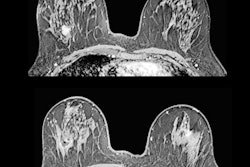
Dutch researchers have found that a reversed contrast-enhanced mammography (CEM) hanging protocol reduces reading time by a third without compromising diagnostic performance. Their study was published online on 15 May in the European Journal of Radiology.
The results are good news for busy radiology departments, wrote a team led by Dr. Koos van Geel of Maastricht University Medical Center.
"In the imaging community, there is some concern about the increased reading time of contrast-enhanced exams, as [they consist] of double the number of images per patient. This might result in substantial increases in workload for radiology staff," wrote the study authors, adding that their investigation shows that this is less of a concern as long as a reversed hanging protocol is used.
Current CEM protocols first display a low-energy image (comparable to a full-field digital mammography study), followed by a postcontrast recombined image, which shows contrast uptake, they explained. But since evidence regarding whether this protocol is the most effective is lacking, they conducted a study to investigate if a reversed hanging scheme could improve reading times.
"At present, all vendors present CEM-cases on their workstations using a hanging protocol ... showing the [low-energy] images first, followed by the recombined images, either as overlay or as a separate image," the authors wrote. "However, evidence on what hanging protocol is most effective is lacking, as there is no knowledge of how radiologists read contrast-enhanced exams in clinical practice."
The study used eye-tracking technology to evaluate reading times for 27 radiologists who were randomized into the following hanging protocols:
- Low-energy/recombined images
- Recombined/low-energy images
The radiologists read 30 contrast-enhanced mammography cases, nine of which were malignant. The eye-tracking software noted readers' fixation count, net dwell time on an image, and time-to-first fixation on malignancies; the team also measured reading time per image.
The reversed hanging protocol of recombined/low-energy images proved identical to other protocols on visual search measures and decreased reading time of the contrast-enhanced images by 31% -- 6 seconds -- while scoring similarly in terms of diagnostic performance, van Geel's team found.
This reading time decrease may seem insignificant when measured in seconds, but it adds up, the group concluded.
"By reversing current the current hanging protocol the radiologist's attention could be immediately drawn to conspicuous areas," the authors wrote. "Radiologists can therefore find lesions up to 31% (6 seconds) faster and can potentially reach higher diagnostic performance if they would evaluate the recombined image prior to the low-energy image."
An average decrease in case reading time of 6 seconds may sound small, but the difference will add up, as radiologists may read perhaps tens or even hundreds of cases on a daily basis, they concluded.



















